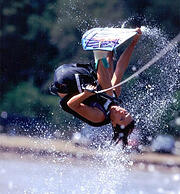
Welcome to this week's TBT post.
You can see where my mind is here in the middle of summer...
This weekend I spent a good amount of time out on the lake with my son and daughter and several others, all of whom were attempting to learn how to wakeboard and surf behind the boat. I grew up on the water and have owned a couple of boats in my day so I am very comfortable behind the boat; skiing and wakeboarding is second nature to me. However, I was struck by how difficult it is to transfer that knowledge to others. Trying to explain the steps it takes to get up on a wakeboard or a surfboard is very difficult. I have noticed some similarities in trying to transfer knowledge to others about Product Lifecycle Management (PLM) as well. As consultants, we tend to immerse ourselves in whatever PLM technology we implement and support, and sometimes this makes it difficult to share how to use the technology effectively in their environments. This blog will discuss how to overcome these challenges and analyze the different ways knowledge can be transferred to end users and administrators attempting to leverage PLM in their companies.
I was listening to some of the other more experienced "boarders" advising my nephew on the best way to get up on the board. I was struck by the mixed messages he was getting. One person would tell him to keep the board flat until the last minute while another told him to turn it. There was a dizzying array of instructions that would make anyone's head spin. Unfortunately, in the end he was unsuccessful in getting up. I also had similar struggles with my son and daughter. They are younger than my nephew and the physical aspects of the sport may have come in to play since neither has been around boats much. Even though experienced wakeboarders make it look easy, getting up can be a little challenging. I think the main problem we experienced was that there was no formal process for instruction and that no one person oversaw communicating the information. Again, I see parallels in the PLM world. As PLM tools become easier to use, formal training becomes less emphasized and this can lead to challenges in adoption and system performance. Given our comfort level with the tools, as consultants, we can forget how difficult it can be for others who do not eat, sleep and drink PLM to understand how the applications work.
Another issue around training is the type of training materials utilized and the delivery method for the training. Web-based training has become the platform of choice for delivering PLM training. Oracle has UPK, PTC has PTC University. Most, if not all PLM vendors offer some sort of web-based recorded training curriculum. While I really appreciate the value of this type of solution, it has limits. Being able to access the training at any time and replay it as needed is very appealing but there is no substitute for interactive instructor-led training. Context is critical when it comes to PLM. Providing generic instruction about the capabilities of the tool will only take you so far. In most cases, each PLM implementation has elements that are unique to one company and their process and generic training cannot address this. It is important that companies adopting PLM or upgrading PLM allocate time and resources for instructor-led training with their content as part of the project if they want maximum value from their system.
It is also important that the training being delivered have some structure and not be an ad hoc exercise where a consultant hops on the system and does a glorified demo via a web meeting. There needs to be some thought and structure behind the curriculum that aligns with the company’s value objectives for the project. This means companies need to expect some cost associated with the curriculum development and that consultants need to take the time to follow this best practice with their clients.
To wrap it up, knowledge transfer can be tricky. There are things that are learned from experience that are difficult to convey via training. Web training and videos are great tools but need to be combined with structured, instructor-led interactive training to yield the best results. If you want to end up on top of the water gliding over the wake you need a focused instructor otherwise you will end up being dragged around plowing the water with your face and feeling quite frustrated. Keep your weight back and your knees relaxed and soon you will be up on top enjoying the view and reaping the benefits of a successful PLM implementation.
[Edit: repost from 2011]



